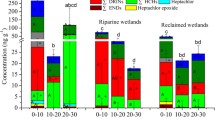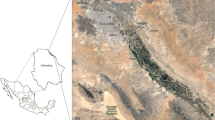Abstract
Aquatic humic substances can react with chlorine during water treatment to form trihalomethanes (THMs). Soils are important contributors to THM precursors in raw waters. An investigation into the trihalomethane formation potentials (THMFPs) of soilsin South China's Guangdong Province was conducted. The results show that the bulk THMFPs (b-THMFP) of aqueous soil extracts range from 0.7 to 36.8 μg g-1 with a median value of 10.6 μg g-1, and the THMFPs of dissolved organic matter(d-THMFP) in the 0.45 μm filtered aqueous soil extracts rangefrom 0.5 to 21.2 μg g-1 with a median value of 3.9 μg g-1 of soil. Approximately 86% of the 34 soil samples had b-THMFP values ≤20 μg g-1 and 79% had d-THMFP values ≤10 μg g-1. The finding that majority of d-THMFP/b-THMFP ratios are less than 0.5 indicates that suspendedorganic matter in aqueous extract has greater contribution to thebulk THMFP. The results of soil column study indicate that THMFPsof effluents from samples 1, 15 and 21 were higher than 100 or 50 μg L-1 at various leaching acidities. THMFPs concentrations in leachates increase with increases in the amounts of humic substances in soils. THM presursors appear to more easily flow out with soil water flow under lower acidicleaching conditions. In most cases, THMFPs concentrations in leachates showed decline with the increases of cumulative leaching volumes of feed solutions.
Similar content being viewed by others
References
Adin, A., Katzhendler, J., Alkaslassy, D. and Rav-Acha, Ch.: 1991, ‘Trihalomethane formation in chlorinated drinking water: A kinetic model’ Wat. Res. 25, 797-805.
Afcharian, A., Levi, Y., Kiene, L. and Scribe, P.: 1997, ‘Fractionation of dissolved organic matter from surface waters using macroporous resins’ Wat. Res. 31, 2989-2996.
Bellar, T., Lichenburg, J. and Kroner, R.: 1974, ‘The occurrence of organohalides in finished drinking waters’ J. AWWA 66, 703.
Boyce, S. D. and Hornlg, J. F.: 1983, ‘Reaction pathways of trihalomethane formation from the halogenation of dihydroxyaromatic model compounds for humic acid’ Environ. Sci. Technol. 17, 202-211
Calace, N., Fiorentini, F., Petronio, B. M. and Pietroletti, M.: 2001, ‘Effects of acid rain on soil humic compounds’ Talanta 54, 837-846.
Fu, J.: 1983, ‘Determining the fractions of bound humus in soil’ J. Soil Sci. 2, 36-37 (in Chinese).
Hayes, M. H. B. and Graham, C. L.: 2000, ‘Procedures for the Isolation and Fractionation of Humic Substances’ in E. A. Ghabbour and G. Davies (eds), Humic Substances: Versatile Components of Plants, Soil and Water, The Royal Society of Chemistry, Cambridge, pp. 91-109.
Li, Qing-Kui: 1983, Chinese Red Soil, Science Press, Beijing, pp. 78-79.
Lin, Cheng-fang, Huang, Yuh-jay and Hao, O. J.: 1999, ‘Ultrafiltration processes for removing humic substances: Effect of molecular weight fractions and PAC treatment’ Wat. Res. 33, 1252-1264.
Liu, W., Tao, S. and Wang, Y.: 1996, ‘Halogenated organics from various fractions of natural organic compounds in water from Jingmi Canal’ China Environ. Sci. 16, 369-372 (in Chinese).
Morrow, C. M. and Minear, R. A.: 1987, ‘Use of regression models to link raw water characteristics to trihalomethane concentrations in drinking water’ Wat. Res. 21, 41-48.
Norin, H., Renberg, L., Hjort, J. and Lundblad, P.: 1981, ‘Factors influencing formation of trihalomethanes in drinking water with special reference to Swedish conditions’ Chemosphere 10, 1265-1273.
Qiu, R. and Wu, Q.: 1997, ‘Study on sensitivity of terriecosystem to acid precipitation’ Advanc. Environ. Sci. 5, 8-22 (in Chinese).
Palacios, M., PampillÓn, J. F. and Rodríguez, M. E.: 2000, ‘Organohalogenated compounds levels in chlorinated drinking waters and current compliance with quality standards throughout the European Union’ Wat. Res. 34, 1002-1016.
Powell, H. K. J. and Fenton, E.: 1996, ‘Size fractionation of humic substances: Effect on protonation and metal binding properties’ Anal. Chim. Acta 334, 27-38.
Rav-Acha, Ch.: 1992, ‘Binding of organic solutes to dissolved humic substances and its effects on adsorption and transportin the aquatic environment’ Water Res. 26, 1645-1654.
Rook, J. J.: 1977, ‘Chlorination reactions of fulvic acids in natural waters’ Environ. Sci. Technol. 11, 478-482.
Rook, J. J.: 1974, ‘Formation of haloforms during chlorination of natural waters’ Water Trmt. Exam. 23, 234-243.
Saito, S., Hattori, K. and Okumura, T.: 1989, ‘Outflows of organic halide precursors from forest regions’ Wat. Sci. Tech. 21, 1877-1880.
Siddiqui, M. S., Amy, G. L. and Murphy, B. D.: 1997, ‘Ozone enhanced removal of natural organic matter from drinking water sources’ Wat. Res. 31, 3098-3106.
Sketchell, J., Peterson H. G. and Christori, N.: 1995, ‘Disinfection by-product formation after biologically assisted GAC treatment of water supplies with different bromide and DOC condent’ Wat. Res. 29, 2635-2642.
Soil Taxonomic Classification Research Group, Institute of Soil Science, Academia Sinica: 1991, Chinese Soil Taxonomic Classification (1st proposal), Science Press, Beijing, pp. 45-91 (in Chinese).
Tao, S., Wang, Y., Liu, W., Lin, B. and Fen, Q.: 1994, ‘Halogenated organics form various fractions of natural organic materials in water from Yinluan channel’ Acta Scientiae Circumstantiae 14, 19-23 (in Chinese).
Visvanathan, C., Marsono, B. D. and Basu, B.: 1998, ‘Removal of THMP by nanorfiltration: Effects of interference parameters’ Wat. Res. 32, 3527-3538.
Xu, J. and Yuan, K.: 1995, ‘Studies on organo-mineral complexes in soils VII. Formation and binding characteristics of soil combined humus’Acta Pedologica Sinica 32, 151-158 (in Chinese).
Author information
Authors and Affiliations
Corresponding author
Rights and permissions
About this article
Cite this article
Li, S., Yang, X., Qiu, R. et al. Contents and Leaching of Trihalomethane Precursors in Soils. Water, Air, & Soil Pollution 145, 35–52 (2003). https://doi.org/10.1023/A:1023608107968
Issue Date:
DOI: https://doi.org/10.1023/A:1023608107968




